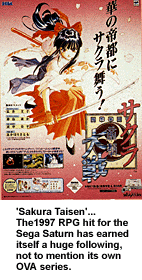-->BACK
What's anime, manga...and whatever?
Anime (read AH-NEE-MAY) is katakana ( ) for 'animation', and refers to Japanese animation. Manga (read MANG-GA) is kanji ( ) for 'animation', and refers to Japanese animation. Manga (read MANG-GA) is kanji ( ) for 'comics' and refers to Japanese comics, though sometimes encompasses animation as well. ) for 'comics' and refers to Japanese comics, though sometimes encompasses animation as well.
For anime, there are three types:

TV-anime: Anime series that's made for airing on TV. The quality of the animation is the weakest, but given the smaller budget and tight deadlines, that's expected. Like the cartoons from the west we get on TV, TV-animes can stretch into a few seasons. There are some exceptions, though. In 1993, Studio Ghibli (known more for full-length features like My Neighbour Totoro and Nausciaa of the Valley of Wind) made a full-length TV-movie Umi ga kikoeru (Ocean Waves) -- a romance drama -- to commemorate 40 years of Nihon Telebi (Japanese Television). Needless to say, the quality for that TV-anime was much better than the usual fare.
Many of the Japanese anime on TCS 8 are TV-animes -- for instance, Maison Ikkoku, Ranma 1/2, Sailormoon etc.

OVA or OAV (Original Video Animation / Original Animation Video) : Anime that's made for release on video, ie VCR or LD. These are animations targeted at home consumers (not necessarily kids, but homes). In most cases, an OVA runs as a series (a few tapes), though much shorter than those made for TV. The quality is better too, and while some are based on a original story, others are spin-offs from popular TV-anime series.
An example of an OVA series that was shown here is Key the Metal Idol, which was on SCV's AXN Channel.

Full-length features: Like Disney, Japanese animation companies also release full-length features every year -- many of them during the summer. Quality varies among them, though generally they're better than both the TV-anime and OVAs. Some (like those by Studio Ghibli) are original stories, while others might be based on a popular TV-anime or OVA series. TV-anime series like Tenchi Muyo, Slayers, and Neon Genesis Evangelion have had movies made. One may say that the quality of these movies are marginally better, though this isn't always the case. Tenchi Muyo In Love!, a featured film released in 1996, for instance, was an above-par production in all aspects.
And of course, there are also the big budget productions that can rival the best from Disney -- many of these coming from companies that are known for animated features. Katsuhiro Otomo's Akira, Memories etc would come to mind. So would Mamoru Oshii's Patlabor movies (based on the TV/manga series, but VERY different in styles), and Ghost in the Shell (based on Shirow Masamune's manga). And of course, there are Studio Ghibli's hits -- including Hayao Miyazaki's latest US$24million masterpiece Mononoke Hime.
 Computer games: Most of them for the Sega Saturn and Sony Playstation. But what's games got to do with anime and manga? Simple -- more and more games are incorporating anime, not just in their introductions, but as cut-scenes. The merging of computer gaming and anime has opened new possibilities for anime, and there are already some good titles out there. Sakura Taisen, for instance, is an RPG that features lots of attractive characters as well as anime-clips; it's hardly surprising that with its popularity, it's now spun an OVA series of its own. The Tokimeki Memorial Drama series have also brought the youth drama genre of anime/manga to games -- and in my opinion, very effectively too. And of course, there are the games based on existing anime/manga titles. To me, this might be one of the futures of anime in particular, with both positive and negative repercussions.
Computer games: Most of them for the Sega Saturn and Sony Playstation. But what's games got to do with anime and manga? Simple -- more and more games are incorporating anime, not just in their introductions, but as cut-scenes. The merging of computer gaming and anime has opened new possibilities for anime, and there are already some good titles out there. Sakura Taisen, for instance, is an RPG that features lots of attractive characters as well as anime-clips; it's hardly surprising that with its popularity, it's now spun an OVA series of its own. The Tokimeki Memorial Drama series have also brought the youth drama genre of anime/manga to games -- and in my opinion, very effectively too. And of course, there are the games based on existing anime/manga titles. To me, this might be one of the futures of anime in particular, with both positive and negative repercussions.
-->BACK
Visions of Escaflowne is copyrighted by Bandai Visual, Macross Plus is copyrighted by Big West, Ghost in the Shell is copyrighted by Masamune Shirow, Kodansha, Bandai Visual, and Manga Entertainment, Sakura Taisen is copyrighted by Sega and Bigred.
|























